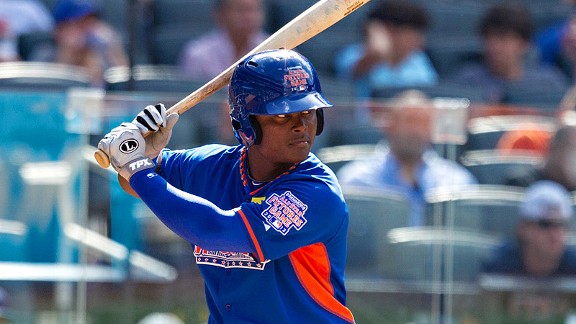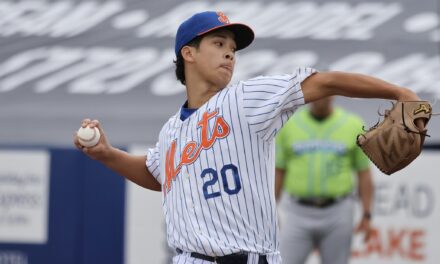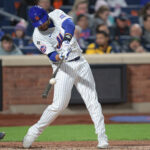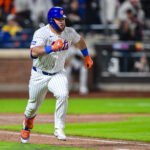
With Tuesday’s trade of Marlon Byrd and John Buck, the Mets got a very intriguing prospect from the Pirates, 19 year-old second base prospect Dilson Herrera.
Herrera is a converted third baseman out of Cartagena, Colombia who is three years into his professional baseball career, and in his second year playing in the U.S., after spending time in the Venezuelan Summer League in 2011. He is listed at 5’10” and 150 pounds, very small, even for a middle infielder. However, he has surprising power for his size.
It’s unusual enough to see a middle infielder hit with power like that at 18 and 19 years old, let alone someone of Herrera’s size doing it in leagues like the Gulf Coast League and South Atlantic League, where you normally don’t see much power. In addition, his walk rate at just below 8% is solid for a middle infielder. His strikeout rate has risen from 15.4% in the Venezuelan Summer League gradually up to 23%, where it sits right now. That’s a bit of a concern, but it’s not something to get too worried about at this point with Herrera being so young.
One of Herrera’s best tools is his speed, which many scouts rate a 60 on the 20-80 scale, making it a plus tool. Speed is odd because it peaks very early and lots of players with “plus” speed in the minors never end up stealing a ton of bases at the big league level. However, at this point expect him to be a 20-30 stolen base type player. He went 16-for-24 on stolen base attempts in 2011, 12-for-16 in 2012, and has gone 11-for-17 so far this season.
Despite being converted to second base, Herrera is improving at the position and could actually end up becoming an above-average second baseman.
Herrera represented the Pirates in the All-Star Futures Game at Citi Field last month, becoming the second-youngest player to ever play in the game.
Overall, Herrera is an underrated prospect with a good hit tool, speed, and solid power at a premium position. Not a bad return for a month of John Buck and Marlon Byrd.
What the experts say…
Scouting Grades (present/future): Hit: 3/6 | Power: 3/5 | Run: 6/6 | Arm: 5/5 | Field: 5/6 | Overall: 3/6
Some international prospects come to the United States and are, at least initially, overwhelmed. Not so for Herrera, who made his U.S. debut in 2012 and was among the Gulf Coast League leaders in a host of offensive categories. He continued his strong play in Class A West Virginia in 2013 until being traded to the Mets in August as a part of the deal that sent John Buck and Marlon Byrd to the Pirates. While Herrera isn’t the biggest guy in the world, he’s shown he can really hit and projects to be an above-average hitter in the future, with more power than you’d expect from a guy his size. A well-above-average runner, the Colombian infielder should be able steal bases consistently, and that speed should also help him with his range as he continues to improve at second base.
Fangraphs Preseason:
If you’re looking for a player who could have a breakout season in 2013 similar to those of Gregory Polanco and Alen Hanson from 2012, look no further than Herrera. The middle infielder generates surprising pop for his size, and that included 25 extra base hits in 60 short-season contests last season. The 19-year-old Colombian needs to tighten up his approach at the plate, including pitch recognition, if he’s going to hit for average as he moves up the ladder.
In the field, Herrera has a below average arm but has good actions and average-or-better range thanks to solid foot speed. He’s played third base, shortstop and second base in his young career but profiles best at the keystone. He should move up to full-season ball in 2013.
Herrera hit .321 for short-season State College in 2012 and led the New York-Penn League with 22 extra-base hits, and despite a dip in his raw production this season at low Class A, he remains an intriguing prospect as an offensive-oriented second baseman. A compactly-built 5-foot-10, Herrera makes consistent line-drive contact and ought to develop at least average power to go with a solid average and on-base percentage. He lacks the type of flashy defensive tools to get a look at shortstop, though sticking at the keystone will be no problem thanks to solid range and quick hands. As such, South Atlantic League managers recently selected Herrera as the best defensive second baseman in the circuit.
Ben Badler on Twitter:
Dilson Herrera is a nice get for the Mets. Good hitter, premium position, solid pop for his size.
— Ben Badler (@BenBadler) August 27, 2013
Dilson Herrera’s bat stood out early on. BA’s amateur (https://t.co/cbtmVUAUgH) and VSL scouting reports on him (https://t.co/zREEuE86m6).
— Ben Badler (@BenBadler) August 27, 2013
Herrera is a right-handed hitter and thrower, born March 3, 1994. He’s not very tall at 5-10, but he is physically strong and generates good power given his size. His eye for the strike zone is uneven and he’s a rather aggressive hitter at this point, with a high strikeout rate. He is primarily a pull hitter at this stage of his career; he also has a strong platoon split, with an .829 OPS against southpaw pitchers but just .730 against right-handed moundsmen.
Defensively, he has good range around the bag at second base, but a mediocre arm precludes usage at shortstop and he’s never played a pro inning there.
Herrera will report to Savannah, where he will likely play out the season.
Follow me on Twitter @UpAlongFirst.














